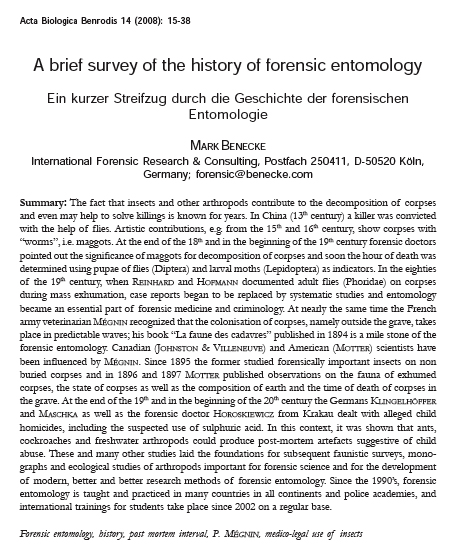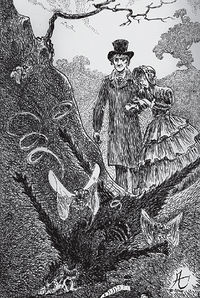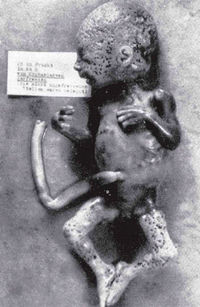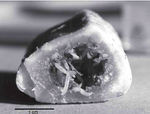2008 Acta biologica Benrodis: A brief survey of the history of forensic entomology: Difference between revisions
No edit summary |
No edit summary |
||
| Line 11: | Line 11: | ||
'''MARK BENECKE''' | '''MARK BENECKE''' | ||
<html><a href="http://benecke.com/pdf/Benecke_A_brief_survey_of_the_history_of_forensic_entomology_Webversion.pdf" target="_blank"><img src="http://wiki2.benecke.com/images/0/04/File-ActabiolBenr_titel.jpg" border="0" height=" | <html><a href="http://benecke.com/pdf/Benecke_A_brief_survey_of_the_history_of_forensic_entomology_Webversion.pdf" target="_blank"><img src="http://wiki2.benecke.com/images/0/04/File-ActabiolBenr_titel.jpg" border="0" height="350" align="middle"><figcaption>Klick aufs Bild, um den Artikel im Original zu lesen!</figcaption></a></html><br> | ||
'''Summary:'''<br> | '''Summary:'''<br> | ||
Revision as of 16:00, 21 December 2015
Source: Acta biologica Benrodis, Vol. 14, 2008, p. 15-38
A brief survey of the history of forensic entomology
Ein kurzer Streifzug durch die Geschichte der forensischen Entomologie
[More Publications by MB] [The article as .pdf]
MARK BENECKE
Summary:
The fact that insects and other arthropods contribute to the decomposition of corpses and even may help to solve killings is known for years. In China (13th century) a killer was convicted with the help of flies. Artistic contributions, e.g. from the 15th and 16th century, show corpses with “worms”, i.e. maggots. At the end of the 18th and in the beginning of the 19th century forensic doctors pointed out the significance of maggots for decomposition of corpses and soon the hour of death was determined using pupae of flies (Diptera) and larval moths (Lepidoptera) as indicators. In the eighties of the 19th century, when REINHARD and HOFMANN documented adult flies (Phoridae) on corpses during mass exhumation, case reports began to be replaced by systematic studies and entomology became an essential part of forensic medicine and criminology. At nearly the same time the French army veterinarian MÉGNIN recognized that the colonisation of corpses, namely outside the grave, takes place in predictable waves; his book “La faune des cadavres” published in 1894 is a mile stone of the forensic entomology. Canadian (JOHNSTON & VILLENEUVE) and American (MOTTER) scientists have been influenced by MÉGNIN. Since 1895 the former studied forensically important insects on non buried corpses and in 1896 and 1897 MOTTER published observations on the fauna of exhumed corpses, the state of corpses as well as the composition of earth and the time of death of corpses in the grave. At the end of the 19th and in the beginning of the 20th century the Germans KLINGELHÖFFER and MASCHKA as well as the forensic doctor HOROSKIEWICZ from Krakau dealt with alleged child homicides, including the suspected use of sulphuric acid. In this context, it was shown that ants, cockroaches and freshwater arthropods could produce post-mortem artefacts suggestive of child abuse. These and many other studies laid the foundations for subsequent faunistic surveys, monographs and ecological studies of arthropods important for forensic science and for the development of modern, better and better research methods of forensic entomology. Since the 1990’s, forensic entomology is taught and practiced in many countries in all continents and police academies, and international trainings for students take place since 2002 on a regular base.
Forensic entomology, history, post mortem interval, P. MÉGNIN, medico-legal use of insects
Zusammenfassung:
Die Tatsache, dass Insekten und andere Arthropoden einen Beitrag zur Zersetzung von Leichen leisten können und generell zur Aufklärung von Tötungsdelikten beitragen können, ist lange bekannt. In China konnte im 13. Jahrhundert ein Mord mit Hilfe von Fliegen aufgeklärt werden. Künstlerische Darstellungen, z.B. aus dem 15. und 16. Jahrhundert, zeigen regelmäßig mit „Würmern” (= Maden) befallene Leichen. Ende des 18. und Anfang des 19. Jahrhunderts wiesen Rechtsmediziner darauf hin, dass Maden einen entscheidenden Beitrag zur Zersetzung von Leichen leisten können, und kurze Zeit später wurde mit Hilfe von Fliegenpuppen (Diptera) und Mottenlarven (Lepidoptera) der Todeszeitpunkt der Leiche bestimmt. Den Schritt von der reinen Fallbetrachtung zur systematischen Untersuchung und Anwendung der Insektenkunde in der Rechtsmedizin und Kriminalistik vollzogen in den 80iger Jahren des 19. Jahrhunderts der Mediziner REINHARD und der Naturforscher HOFMANN, die bei Massenexhumierungen auf den Leichen erwachsene Buckelfliegen (Phoridae) entdeckten. Etwa zur selben Zeit erkannte MÉGNIN in Frankreich, dass die Besiedlung von Leichen – besonders auch außerhalb des Grabes – in vorhersagbaren Wellen abläuft. Sein 1894 erschienenes Buch „La faune des cadavres“ gilt als Meilenstein der forensischen Entomologie. Seine Konzepte beeinflussten die kanadischen Forscher JOHNSTON & VILLENEUVE, die seit 1895 umfangreiche forensisch-entomologische Untersuchungen an freiliegenden Menschenleichen durchführten, sowie MOTTER in den USA, der 1896 und 1897 die Fauna exhumierter Leichen bestimmte sowie Leichen- und Erdbeschaffenheit und Liegezeit im Grab bestimmte. Gegen Ende des 19. und Anfang des 20. Jahrhunderts befassten sich die deutschen Ärzte KLINGELHÖFFER and MASCHKA sowie der Rechtsmediziner HOROSKIEWICZ aus Krakau mit angeblichen Kindstötungen mit Hilfe von Schwefelsäure. In diesem Zusammenhang konnte gezeigt werden, dass Ameisen, Schaben und Süßwasser-Arthropoden postmortale Schäden verursachen können, die wie Kindesmissbrauch aussehen. Diese und zahlreiche andere Untersuchungen legten den Grundstein für nachfolgende Monographien über forensisch wichtige Arthropoden, für diesbezügliche faunistische und ökologische Studien sowie für die Entwicklung moderner und immer präziserer Methoden der forensischen Entomologie. Seit den 90iger Jahren des vorigen Jahrhunderts wird forensische Entomologie in zahlreichen Ländern auf nahezu allen Kontinenten gelehrt und praktiziert. Außerdem gibt es seit 2002 regelmäßig internationale Schulungen.
Forensische Entomologie, Geschichte, Liegezeitbestimmung, P. MÉGNIN, kriminalbiologischer Nutzen von Insekten
1. Introduction
Hundreds of arthropod species are attracted by corpses, primarily flies (Diptera), beetles (Coleoptera) and their larvae, respectively, but also mites, isopods, opiliones and nematodes can be found. These animals feed, live or breed in and on the corpse, depending on their biological preferences and on the state of decomposition. Since arthropods are by far the largest and most important biological group on earth (they outnumber even plants), they can be found in a wide variety of locations including crime scenes. This opens a wide range of applications for forensic entomology,
the investigation of insects recovered from crime scenes and corpses. The following article gives a brief survey of the historic sources describing the development that led to the present state of the art with a major focus on work done between 1850 and 1950 (BENECKE 1998, BENECKE 2001a, BENECKE & LECLERCQ 1999).
2. Medieval China to 19th century
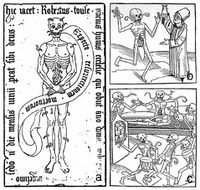
The first documented forensic entomology case is reported by the Chinese lawyer and death investigator SÒNG CÍ in the 13th century in the medico-legal text book (Xiyuan jílù; one possible translation: “collected writings on the washing away of wrongs”). He describes the case of a stabbing near a rice field. The day after the murder, the investigator told all workers to lay down their working tools (i.e., sickles) on the floor. Invisible traces of blood drew blow flies to a single sickle. So confronted, the tool’s owner confessed to his crime and “knocked his head on the floor” (Fig. 1; see SÒNG CÍ/SUNG TZ’U 1924; MCKNIGHT 1981). It took nearly eight hundred years until the next Chinese book on forensic entomology was published (HU 2000). In addition to medical and legal experts, sculptors, painters and poets have closely observed the decomposition of human bodies, noting, in particular, the effects of feeding maggots. Early documents illustrating maggots on corpses date to the Middle Ages, including woodcuts from “Dances of the Death”, oil paintings (both 15th century), engravings in tombstones (19th century), and the intricately cut ivory carving, “Skeleton in the Tumba” (16th century, Figs. 2-4) (BENECKE 1999). Detailed observations were possible not only from victims of the frequent and violent wars but also exposure to decomposing bodies during plague outbreaks and similar diseases; the plague alone killed 1/3 of all Europeans in the years 1346-1351. Such artwork accurately depicts the insectmediated pattern of body mass reduction, particularly the skeletonization of the skull and the reduction of internal organs, with large parts of the skin left intact (LANGLOIS 1852; STAMMLER 1948); however, a metaphoric connotation is sometimes also present, e.g. the maggots as “snakes” (Fig. 3), and the blowfly replacing the heart (Fig. 4). Also, the poem “Une charogne” by the French poet C. BAUDELAIRE (1821-1867) must be mentionedin this context, too, since it contains very good observations on the decay of human bodies, including an accurate reference to the sound of maggot masses on corpse (see BAUDELAIRE 1857):
“Et ce monde rendait une étrange musique, Comme l’eau courante et le vent, Ou le grain qu’un vanneur d’un mouvement rhythmique Agite et tourne dans son van.” (BAUDELAIRE 1955)
A century earlier, in 1767, the natural scientist C. VON LINNÉ made the observation that three flies would destroy a horse as fast as alion would (in the sense of them producing large masses of maggots) (LINNÉ 1775) (Fig. 6).
3. Early cases from France
During mass exhumations in France and Germany in the 18th and 19th centuries, medico-legal doctors observed that buried bodies are colonized by arthropods of many kinds. In 1831, the famous French medical doctors ORFILA & LESUEUR (1831, 1835) observed a large number of exhumations. They understood that maggots play an important role in the decomposition of corpses (Fig. 7). The first modern forensic entomology case report to include an estimation of postmortem interval (PMI) was given by the French doctor BERGERET (1855). The case dealt with blow fly pupae and larval moths. Though BERGERET was by profession a hospital physician (at the Hopital Civil d’Arbois), his interest in cadaver study is clear, as he states that a corpse dealt with by him resembled those he had observed found in other locations (i.e., “in the hot and dry lands (“pays chauds”) on the cemetery of the Capucins of Palerme”, or “in Toulouse”). His original report to the court was dated March 28, 1850. In his journal article, next to a long description of the criminal impact in the trial, he also describes the court proceedings: “Within three years, four different tenants [i.e., families] lived in the flat. The first of them left in December 1848, and the person examined started to live there at the end of 1844. I [i.e., BERGERET] was brought to the house of Mme. Saillard [i.e., the landlady] in rue du Citoyen, 4, (...) to examine the corpse of a child. (...) Length of corpse: [46 cm]. [Then details on measurements of bones, state of internal organs, etc. follow.]. The questions we had to deal with now were: 1. Was the child born regularly/at the right time, 2. Was it alive when it was born, 3. How long did it live, 4. How did it die?, 5. What was the time interval between birth and death?” Questions 1 to 4 were answered with classical forensic pathology. Question 5 was commented in the following way:
“To answer this question, legal medicine must check with another science, the natural sciences.” However, BERGERET (1855) does not state whether he worked together with another person. In his paper, BERGERET (1855) gives a brief overview on the life cycle of insects in general. He mistakenly assumes, however, that metamorphosis would generally require a full year. Furthermore, he assumes that females generally lay eggs in summer and that the larvae would transform to pupae (he calls them nymphs) the following spring and hatch in summer. Some details of BERGERET’s calculation: “The eggs of the larvae we found on the corpse in March 1850 must have been deposited there in the middle of 1849. Therefore, the corpse must have been deposited before this time interval. Next to the many living larvae there were numerous pupae present, and they must come from eggs that have been laid earlier, i.e., in 1848. (...) Could it be that the corpse was deposited even before that time [i.e., 1848]? The fly that emerges from the pupae that we found in the body cavities, is Musca carnaria L. that lays its eggs before the body dries out. We found other pupae of little butterflies of the night [moth], too, that attack bodies that are already dried out. If the body was deposited, say, in 1846 or 1847, we would not have found those larvae [since they would have hatched]. In conclusion, two generations of insects were found on the corpse, representing two years postmortem: on the fresh corpse, the flesh fly deposited its eggs in 1848, on the dried out corpse, the moth laid their eggs in 1849.” In retrospect, one should understand that BERGERET did not focus on forensic entomology in his report but used the method as one forensic tool among others. Indeed, the mummification of the cadaver appears to be his overriding issue of interest in this case. BERGERET references ORFILA & LESUEUR (1831, 1835) in the matters of both mummification and forensic entomology. He also clearly notes the lack of knowledge concerning insect succession on corpses in his day. In 1879, the president of the French Society of Forensic Medicine, BROUARDEL reported another early case. P.C.H. BROUARDEL, born in Saint-Quentin on 13 February 1837, became a member of the French Academy of Medicine in 1880. He worked on tuberculosis, vaccination and legal medicine. His numerous medico-legal accounts include practical guidelines for his colleagues in the morgue. A contemporary said that “his work is conscientious, clear, methodic, and serves as a model” (quote from encyclopedia of that time; retrieved in 1998 by MB in Manhattan (New York University (NYU) Hospital Library); exact title and year unknown.) In his report, after referencing the work of BERGERET (l.c.), BROUARDEL (1879) describes the case of a newborn child that was autopsied by him on January 15, 1878. The mummified body was inhabited by several arthropods, including butterfly larvae and mites, which led to a request for assistance from Monsieur PERIER, professor at the Museum of Natural History in Paris, and army veterinarian J.P. MÉGNIN. PERIER reported that the body was most likely dried out before it was abandoned. The determination of mites was left to MÉGNIN whereas PERIER determined the butterfly larvae as “chenilles d’aglosses”, i.e., larvae from the genus Aglossa (small moth, family Pyralidae). From the state of preservation and from the larvae found, PERIER stated that the baby may have been born and died the summer before (“de l’été dernier probablement”), i.e., around six to seven month before the corpse was autopsied. MÉGNIN (1894) reported that the whole body was covered with a brownish layer composed exclusively of mite skins and mite feces, but not living mites. Inside the cranium he found large numbers of a single mite species. Initially, a few larval mites must have been carried to the corpse by other arthropods. MÉGNIN (1894) calculated that on the whole body 2.4 million dead or living mites were present. He also calculated that after 15 days the first generation with 10 females and 5 males had developed; after 30 days, 100 females and 50 males; after 45 days, 1,000 females and 500 males. Finally, after 90 days, 1 million females and 500.000 males were present. Since this was the number of individual he estimated being on the corpse, he made a conservative guess and reported that the corpse must have been abandoned for at least five months (three months of mite development, preceded by two months for desiccation) but more likely seven to eight months. This is the same case as Case No. 12 in MÉGNIN’s “La faune des cadavres” (see below for details; Fig. 8), and MÉGNIN states that this is his “prémiere étude médico-légale” (first medico-legal study). In a period of nine years, he published four articles on the topic (MÉGNIN 1887, 1889, 1894, 1896). This case also illustrates nicely how early researchers in the field investigated the use of molds, slime fungi, crustaceans, mites, and plants in addition to insects.
4. Further mass exhumations
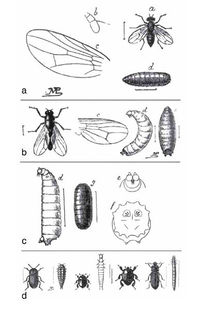
On April 6, 1881, the German medical doctor REINHARD, born in Dresden on November 15th, 1816, reported the first systematic study in forensic entomology (REINHARD 1882). Dealing with exhumed bodies from Saxonia, he collected mainly phorid flies taxonomically identified by the entomologist BRAUER in Vienna. He also described beetles in graves older than 15 years. In some instances, he found the insects breeding within cracks of adipocire. But REINHARD concluded that their presence may have more to do with their feeding on plant roots protruding into the graves rather than any direct association with the corpses. REINHARD’s work remained well known for a long time, and in 1928 an extensive citation of his paper appeared in the work of the phorid fly expert (see SCHMITZ 1928) and in other scientific articles. Another entomological report of exhumations, this time from Franconia, was given by HOFMANN in 1886. HOFMANN found phorids, too, and identified them as Conicera tibialis Schmitz, 1925, today known as the “coffin fly”. Around the same time, the 60 year old doctor J.P. MÉGNIN started to develop his theory of predictable, ecological waves of insect life on corpses. MÉGNIN, born in Herimoncourt (Doubs) on January 18, 1928, went to school at the Ecole d’Alfort from 1849 till his graduation in 1853. In 1855, he became an army veterinarian (quote from encyclopedia of that time; retrieved in 1998 by MB in Manhattan (New York University (NYU) Hospital Library); exact title and year unknown.). His books include “Maladies de la Peau des Animaux” (1867-1882), and “Maladies parasitaires” (1880). MÉGNIN likewise worked on Acari (publications in this matter date between 1876 and 1879) and reported some of his results in his book “Faune des Tombeaux” (Fauna of the Tombs, 1887). No affiliation to a university or a Museum of Natural History was mentioned in his articles, and because he became a member of the French Academy of Medicine in 1893, one might conclude that he considered himself primarily a medical doctor. MÉGNIN drew on his 15 years of medicolegal experience with corpses in publishing 14, mostly brief, papers between 1883 (see ANONYMUS 1883) and 1896. He found fault in the dissertation of his younger French colleague G.P. YOVANOVITCH, of the Faculty of Medicine, Paris, on the same subject (YOVANOVITCH 1888). MÉGNIN was under the impression that YOVANOVITCH’s data were not sufficiently precise. Previously, the two researchers had co-operated in the sense that YOVANOVITCH was allowed to use MÉGNIN’s data, including tables of mites and the succession
table of five cadaverous fauna waves that YOVANOVITCH titled ”Toilers on the Dead” (“Les travailleurs de la mort”, obviously being a pun related to the book “Toilers of the Sea” (“Les travailleurs de la mer” by the French author V. HUGO, 1866). Finally, in 1894, MÉGNIN published his book “La faune des cadavres” (Fig. 8). In it, he expanded his former theory of four insect waves for freely exposed corpses to eight successive waves. For buried corpses, he reported two waves. The book dealt with larval and adult forms of a number of families, and its drawings focused on wing venation, posterior spiracles, and overall anatomy of the insects for identification (Fig. 9). MÉGNIN also describes 19 case reports, including his own cases between 1879 and 1888. (Some of the cases were in co-operation with BROUARDEL.) He cites his original statements given in court as well as the basic questions asked of him as an expert witness. In addition to advancing the science of forensic entomology MÉGNIN’s work greatly popularized the subject. His contributions to our knowledge of the arthropod fauna of graves and the general fauna and flora of mummified, or otherwise decayed, corpses was later honored in the naming of the mold Endoconidium megnini. In 1897, inspired by MÉGNIN, the Canadian researches W. JOHNSTON and G. VILLENEUVE, of Montreal, started a number of systematic entomological studies on human corpses. The two scientists write of MÉGNIN: “(...) in no single instance did the results of the inquiry go to show that MÉGNIN’s deductions were erroneous. (...) The chief danger to be feared from MÉGNIN’s imitators is that they might tend to indulge in guesses having no very solid basis and to apply rules to countries and climates where they were inapplicable.” They aimed to refine the work of MÉGNIN and to adapt it to their local faunas. Another study on this subject had already been set up by M.G. MOTTER, “Volunteer in the United States Bureau for Animal Industry”, and his co-workers a few years previous.
Shortly after, in the summers of 1896 and 1897, MOTTER‘s group systematically and critically checked more than 150 exhumed corpses from Washington, D.C. In his report, MOTTER (1898) provides brief descriptions of the entomological findings as well as brief comments on soil type, grave depth, etc. A speech he “read before the public section of the British Medical Association” in 1897 carried the title “Underground Zoology and Legal Medicine” (MOTTER 1897). Another report in 1895 came from Sweden where SCHÖYEN gave an overview of work that could be applied to the investigation of “graveness fauna”, or the fauna of graves. (SCHÖYEN 1895). However, he refers primarily to species already mentioned in REINHARD’s and MÉGNIN’s publications. The only forensic entomology studies of that time no longer available are those performed by HOUGH in New Bedford from 1894 to 1897, as he never published his data.
5. Turn of the century
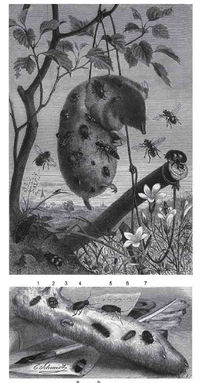
Previous forensic insect studies by the German doctors KLINGELHÖFFER and MASCHKA, and the forensic pathologist S. VON HOROSZKIEWICZ from Krakow University (then Austria, now Poland), had focused on the bite patterns of cockroaches and ants. KLINGELHÖFFER (1898), a district medical doctor responsible for the Frankfurt area, relates the case of a poor family, whose nine month old, sickly baby died on May 26, 1889, and was autopsied three days later, on May 29. In the meantime, the local “doctor responsible for the poor” had filed a report to the police because he had observed patches in the face of the child, leading to the father’s arrest. During the resulting autopsy, the “patches” were noted on the nose and lips and to proceed downwards from the child’s mouth. The tongue was not discolored, but bleeding on the tip. Of particular interest to the police was confirmation of their suspicions that the father had tried to make the child drink sulphuric acid, a common method of poisoning at that time. However, KLINGELHÖFFER found no signs of poisoning, and concluded that the abrasion-like patterns had most likely been caused by cockroaches. The father was released after three weeks in prison (KLINGELHÖFFER 1898). HOROSZKIEWICZ (1902) dealt with a similar case, in which a child was autopsied in April, 1899. The autopsy found no internal signs of violent death, however, numerous abrasions could be seen on the nose, cheeks, lips and chin, with more obvious marks on the surface of the neck and backside of the left hand, fingers, genitals and the inner thighs. When questioned by HOROSZKIEWICZ, the mother stated that when she came home from preparing for the funeral, the body of her child had looked as if it was covered with a black shroud (“mit einem schwarzen Leichentuche bedeckt”, p. 236) of cockroaches, but she did not see any abrasions at that time. To verify whether the cockroaches could be the sole cause for the abrasions, HOROSZKIEWICZ put pieces of fresh tissue from human corpses in glasses filled with cockroaches. While no obvious signs of cockroach feeding were apparent immediately after the feeding activity, they became visible when the skin dried, explaining why the mother had not seen the abrasions but the medical examiners had. Similar cases were reported by medical examiner MASCHKA (1881) from Austria who became involved in high profile cases in the modern sense of the phrase. In one case, he found abrasions on a child whose body was discovered in a well. It was believed that a sexual offender may have abused the child and then strangled, or throttled, it before throwing it in the well. MASCHKA, however, concluded that the lesions must have been caused by arthropods. In another case, it was thought that a father may have killed his threeday-old child by forcing it to drink sulphuric acid. The father, however, stated that he had put the child, after it had died of natural causes, near the window at 22:00 hrs on April 14, 1880. He reported that on 04:00 hrs the next day, the child’s head, located under a blanket, was already covered with ants. MASCHKA’s findings at autopsy were consistent with the father’s account. Another experimental account was given by E. RITTER VON NIEZABITOWSKI (1902), also a medical examiner at the Medico-Legal Institute of Krakow University. His experiments were performed from May, 1899, to September, 1900, using aborted fetuses and cat, fox, rat, mole and calf cadavers that he put on the windowsill in the institute as well as in a nearby vegetable garden. His observations dealt primarily with flies: calliphorids, Lucilia caesar, Sarcophaga carnaria, and “Pyophila nigriceps” (most likely, cheese skippers Piophila casei); but it also included beetles, mostly Silpha, Necrophorus or Dermestes. His important contribution to the field was the experimental proof that human corpses share the same fauna with animal corpses, both vertebrate and invertebrate. Meanwhile, turn-of-the-century France and Germany enjoyed a general increase in interest in zoological studies including invertebrate life. As evidence, we see the great success of two popular book series from that time, “A. BREHMs Thierleben“ (BREHM 1876-1879, Fig. 10), and even more “J. H. FABRE’s Souvenirs entomologiques” (FABRE 1879-1909) with its German edition (FABRE 1908-1910; see Fig. 11), among other topics specifically dealing with carrion beetles and blow flies. These books, still well-known to the public in Central Europe, inspired an interest in entomology in large numbers of people. Among the lasting benefits of this popularity are numerous ecological studies that continue to be drawn upon in forensic case studies today. In 1907, C. MORLEY published an article in England dealing with the question of what species should be classified as carrion beetles. He stated that during ten years of collecting he found that winter was “almost the best time” for carrion beetles and that there are (so-called) carrion beetles that are not carnivorous but “act as final dissolvers to the ancient carcasses. (...) it is still a mystery to me what N[ecrophorus] vespillo feeds upon.” Papers like this were the early basis for the systematic ecological studies that have influenced forensic entomology since the 1920’s. In 1912, there was even a paper presented at the German Society for Forensic Medicine (ANONYMUS 1912), and in 1919, there was even a report by HUNZIKER dealing with the fauna and flora found in graves in Basel (Switzerland).
6. Circa the World Wars
Beginning in the 1920s, species lists and monographs on forensically important insects were finally published, with a focus on ecology, metabolism or anatomy. Pest control, and “maggot therapy” were both of growing interest during this period, and many contributions stemmed from these fields, creating a major scientific source for interpretation of forensic insect evidence. In the context of pest control, for instance, it was found that adult flies may be present near dying persons or animals before their actual death. It also became popular to investigate the entomological status of ancient mummies. The interest in maggots on corpses remained high in 1922, when K. MEIXNER, professor at the Institute for Legal Medicine in Vienna and Innsbruck, reported cases in involving bodies that quickly disintegrated while being put into storage in the institute’s basement (MEIXNER 1922). This rapid disintegration was most dramatic with juvenile corpses. Apart from references to ORFILA and MÉGNIN, no further data were collected by MEIXNER. A few years later, H. MERKEL, professor at the Institute for Legal Medicine in Munich, extended MEIXNER’s observations with case reports that demonstrated that the circumstances of death could influence the course of insect succession. In a case from summer 1919, a son had killed his parents and stored the bodies next to each other for three weeks. At autopsy, the bodies were found to be in different states of decomposition: The obese body of the mother (shot
in the heart) was in full bloated decay, with both eyeballs destroyed by the actions of maggots and numerous maggots already present inside of the (liquefying) brain tissue. Her internal organs were comparably intact and no maggots were present inside of the fat layers. By contrast, the father’s slim body had already been infested with numerous maggots in all cavities, with all internal organs destroyed and pupae already developed. The reason for the increased maggot presence in the father’s body was that he had not only been shot but also repeatedly stabbed. This attracted flies to deposit eggs not only in the facial area but also into the wounds. In another case, MERKEL found the mummified body of a person who died at home, with not one single maggot being present (MERKEL 1925). In Italy, G. BIANCHINI, director of the Institute for Legal Medicine of Bari University, wrote a “contribution to the practical and experimental study of the fauna of corpses” in 1929. BIANCHINI’s case report deals with the corpse of a four-year-old child that had driedout lesions of the skin on the ears, arms, the abdominal area and the upper side of the thighs. Arthropods collected from the body included mites, “very small scorpions”, small beetles and ants. Identification of the ants was performed by C. MINOZZI, and after further experimentation, BIANCHINI concluded that the lesions must have been caused by ants of the same species as found on the corpse within a period of around 24 hours. A former case report of RAIMONDI & ROSSI (1888) dealt with the influence of Gammarus pulex, a freshwater crustacean, on corpses. The authors found that Gammarus can produce large numbers of small needle-like lesions. In their case report, it was concluded that a body had been stored in a freshwater containment. The only case report during the 1930’s seems to come from F.J. HOLZER, medical examiner at the Institute for Legal Medicine in Innsbruck, Austria. HOLZER (1939) investigated the type of destruction caused by caddis flies feeding on corpses submerged in freshwater. In an actual case from April 1937, he found that caddis flies had destroyed all skin layers of the thighs up to the lower border of a pair of shorts as well as larger parts of the facial skin (Fig. 12). It was late winter/early spring with low temperatures, and there had clearly been no blowfly maggots present. HOLZER had never observed such patterns of destruction, even in cases where caddis fly casings had actually been present on corpses. Therefore, he collected caddis flies from the body of water in which the corpse had been found and put them in three aquariums containing an aborted fetus, a rat and a guinea pig, respectively. In doing so, he demonstrated that caddis flies were the cause of the lesions observed on the child. In 1933, K. WALCHER from the Institute for Legal Medicine in Munich reports that he found maggots entering the spongiosa of long bones to reach the bone marrow (circumstances: suicide, post mortem interval 100 days outside). Since the skeleton was intact, WALCHER (1933) suggested that the animals crept through foramina nutritia, tiny gaps in the bones that allow blood vessels, and nerves to enter the bones. (I observed similar but always and only with cheese skipper larvae, Piophila casei, which are much smaller than blowfly larvae (Fig. 13)).
7. After the World Wars
During the 1940’s, only a note of J. BEQUAERT (ANONYMUS 1945) seems to deal with the use of insects to determine the postmortem interval. In the 1950’s, H. CASPERS from the Zoological Institute and Museum of the State Hamburg introduced the use of caddis fly casings as a tool for forensic investigation (Fig. 14; CASPERS 1952). The body of a dead woman, naked except of a pair of red socks and wrapped in a sack, had been found in 1948 in a moat of a windmill. The question was if the body was disposed there immediately after the killing or if it was stored elsewhere before it was dumped. In a caddis fly casing (most likely of Limnophilus flavicornis) that was found on one sock, fibers of the red socks had clearly been used to build the casing. However, the fibers were only found at the very top, and the very bottom of the casing which meant that the fly had already built her case before she entered the sack. She then finished the
casing (fibers on top) and attached it to the sock (fibers on bottom). Since the attachment procedure lasts at least some days, it was estimated that the body was lying in the water for at least one week. Further criminal evidence led to the conclusion that the entomological result indicated that the body had been stored elsewhere before it was dumped. With the description of CASPER’s case, our historic survey on forensic entomology ends.
8. Recent History
Between the 1960’s and 1980’s, forensic entomology was maintained primarily by LECLERCQ (1968), LECLERCQ & QUINET (1949), LECLERCQ & BRAHY (1990) (Belgium) and professor of biology P. NUORTEVA ET AL. (1967, 1974) (first, Helsinki Zoological Museum, later, professor at the Department of Environmental Protection and Conservation, University of Helsinki, Finland, Fig. 15), with a focus on case work, German doctors with a specialization in forensic medicine POLLAK & REITER (1988), REITER (1984, 1985), REITER & WOLLENEK (1982, 1983, 1985) and REITER & HAJEK (1984), and in the United States, by GOFF (2000), GREENBERG & KUNICH (2002), LORD et al. (1986, 1992, 1994, 1998) and LORD & BURGER (1983), amongst others (Fig. 16). NUORTEVA (1977) and NUORTEVA ET AL. (1974) wrote an important and quite lengthy handbook article about forensic entomology that inspired many researchers (e.g. NUORTEVA 1977). K. SMITH, then head of the fly collection in the British Museum (London), published the very influential “Manual of Forensic Entomology” (1985, 1986) that, in his own words, holds mostly historical value but in spite of this is still in good use in some laboratories. Since then, basic research and advanced application of forensic entomology opened the way to routine casework. It seems that recent high profile cases (Fig. 17), popular science accounts and textbooks (Figs. 8, 16) as well as international trainings (e.g., at the FBI Academy (Quantico) at the Anthropological Research Facility (Univ. Tennessee) and at the University of Cologne) helped most to establish the discipline in current routine police and forensic practice. By now, researchers worldwide use entomology in criminal investigations including murder, child neglect and crimes against animals. The French State Police (Institute de Recherche Criminelle de la Gendarmerie Nationale) is one of the few police institutions with a fully equipped and operational laboratory; most of the other forensic entomology laboratories are based at universities with very unstable funding. There is still a lot of room for research, expansion and improvement, not only because of climatic changes that strongly affect insect communities but also because of a lack of proper job
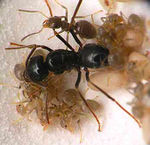
offers for the past and for the next generation of forensic entomologists (INTRONA & CAMPOBASSO 1998; ERZINÇLIOGLU 2000; BYRD & CASTNER 2001; BENECKE 2001b, 2004)
Acknowledgements
Burkhard MADEA for bringing to my attention the painting “Les aments trespasses” and to the Frauenhausmuseum, Strasbourg, for providing extra information. Hartmut GREVEN and Kristina BAUMJOHANN meticulously edited the script. Corinna BREMER helped with the complicated Chinese translations and phonetic transcriptions.
References
Take a look at the .pdf

